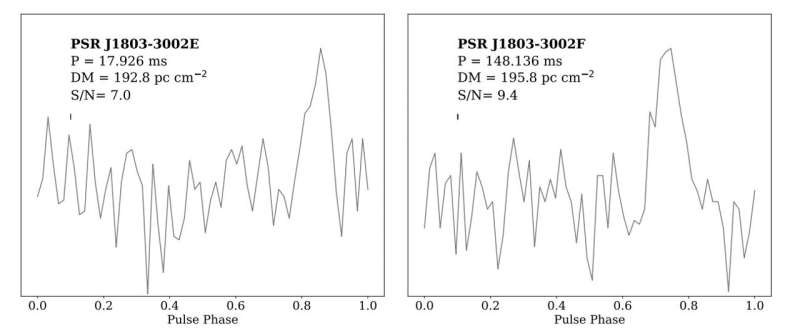October 16, 2023 report
This article has been reviewed according to Science X's editorial process and policies. Editors have highlighted the following attributes while ensuring the content's credibility:
fact-checked
preprint
trusted source
proofread
Two new pulsars detected in globular cluster NGC 6522

Using the MeerKAT radio telescope, an international team of astronomers has observed a Galactic globular cluster known as NGC 6522. As a result, they have discovered two new isolated pulsars in this cluster. The finding is reported in a paper published October 5 on the pre-print server arXiv.
Pulsars are highly magnetized, rotating neutron stars emitting a beam of electromagnetic radiation. Astronomers searching for new pulsars focus their observations on globular clusters (GCs), as such gravitationally bound collections of stars are ideal factories for the formation of a large variety of astronomical objects.
Recently, a group of astronomers led by Federico Abbate of the Max Planck Institute for Radio Astronomy in Bonn, Germany, has conducted a search for new pulsars in NGC 6522 as part of the MeerTIME and TRansients And PUlsars with MeerKAT (TRAPUM) projects.
NGC 6522 is a core-collapsed Galactic GC at a distance of about 25,100 light years, with a mass of about 300,000 solar masses. Its age is estimated to be 12 billion years, therefore it may be the oldest star cluster in the Milky Way galaxy.
"In this manuscript we report the discovery of two new isolated pulsars in NGC 6522 in observations made with the MeerKAT telescope," the researchers wrote.
The team discovered two isolated pulsars and designated them PSR J1803−3002E and PSR J1803−3002F. With this finding, the total number of known pulsars in NGC 6522 is now six, and all of them are isolated.
PSR J1803−3002E is a mildly recycled millisecond pulsar (MSP) with a spin period of approximately 17.9 milliseconds, found near the center of NGC 6522. Its dispersion measure was found to be around 192.8 pc/cm3.
PSR J1803−3002F is a slow pulsar with a spin period of about 148.1 milliseconds at a distance of some three core radii from the center of the cluster. The dispersion measure of this pulsar was estimated to be 195.8 pc/cm3.
The researchers noted that the spin period of the two newly detected pulsars is higher than that of the previously known ones. They added that the characteristic age of PSR J1803−3002F may be smaller than the age of NGC 6522.
The study also found that one of the millisecond pulsars previously identified in NGC 6522, designated PSR J1803−3002C, may have a small characteristic age of only 132 million years. If confirmed, this pulsar would have one of the smallest characteristic ages among the known MSPs in globular clusters.
"The presence of a slow pulsar and an apparently young MSP, both rare in GCs, suggests that their formation might be linked to the evolutionary stage of the cluster," the authors of the paper concluded.
More information: A MeerKAT view of the pulsars in the globular cluster NGC 6522, arXiv (2023). DOI: 10.48550/arxiv.2310.03800
Journal information: arXiv
© 2023 Science X Network




















